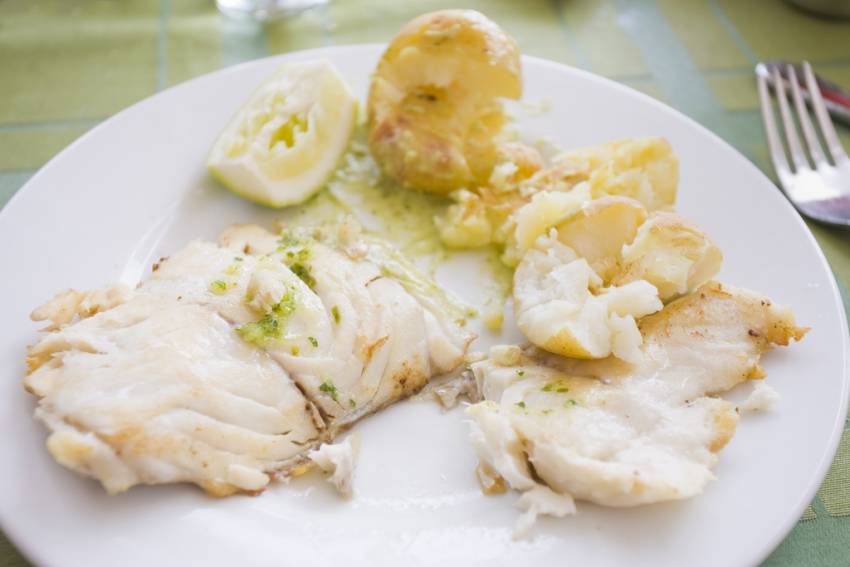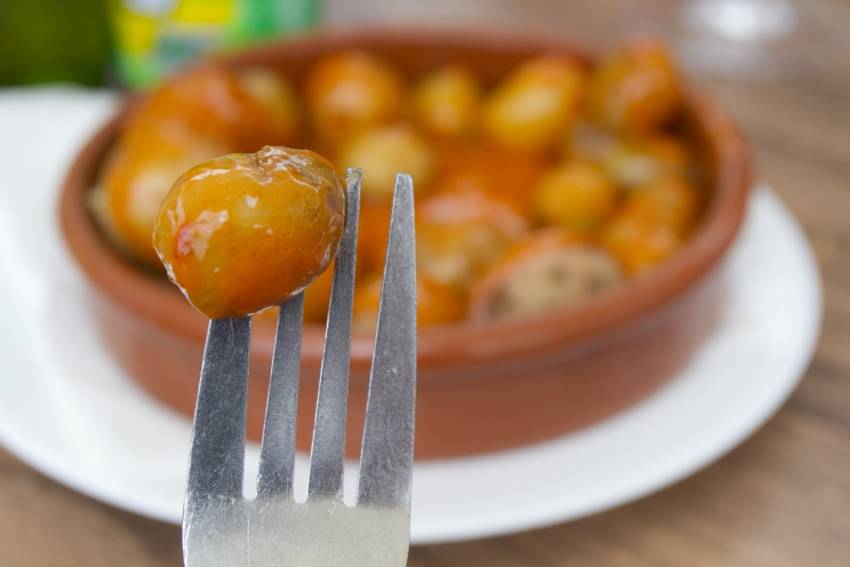The Many Mojos And How to Majar Them
Red mojo or green mojo?
This is always the most answered question on our Facebook page and the red version is slightly more popular. This is probably because it comes on the papas arrugadas (wrinkly popes as they are sometimes translated on local menus). Somehow, red and green are the only two mojo variations that make it onto restaurant tables. But there is far more to mojo than a binary choice.
From red and green to almond and avocado
Almond mojo is made from garlic, pimentón and peeled almonds pounded with olive oil in a pestle ands mortar. In La Palma they add smoked cheese to green mojo, in El Hierro fresh cheese to red mojo. In La Gomera they add hard cheese to the mojo and and call it almogrote.
Then there's the superb but rarely made mojo de aguacate based on avocado, herbs, green chili and cumin. Even with the standard red and green versions, every family has their own mojo recipes.
Oregano in the green? Parsley! What about tomato in the red? Roasted tomato! Are you crazy? That is not traditional! It is in my village!
The only thing people can agree on is that the best version is made by their gran.
The truth is that mojo isn't about the exact amount of chili, spice or vinegar in the mix. It's about the effort you put into mixing it.
Throw all the ingredients into a blender and after a good blitz you get a passable mojo. But for a great sauce use a big, stone pestle-and-mortar and spend a good 15 minutes majando el mojo; grinding everything together as you gradually add the oil. The constant mixing emulsifies the oil and garlic and really gets the chili and spices infused. Mojo that is majado looks different too; thicker and textured rather than runny and homogenous. Like lava rather than ketchup.
To make an ever richer mojo, add avocado...
Avocados and the Canary Islands
Avocadoes are from Central and South America and arrived in the Canary Islands centuries ago. Canarians were eating them in salads long before the brunch revolution made them a supermarket staple. As a kid I had avocado and jamon Serrano bocadillos for school lunch.
So mojo de aguacate isn't just a reworking of guacamole to hitch Canarian food to the avo bandwagon. It's a bona fide Canary Islands recipe made by local grannies for generations.
It's also delicious!
Mojo de aguacate: The recipe
I'd like to say that this is my gran's mojo de aguacate recipe but she was from Liverpool. Nana made a mean apple pie but never really dabbled with garlic and only ate avocadoes halved with Worcestershire sauce in the hole.
So instead this is my mojo de aguacte recipe honed during the lockdown and tested on two fussy kids.
You need...
- A large avocado (a ripe Haas variety with the crinkled skin is best; check ripeness by wiggling the stump of the stalk. If it falls off easily, the avocado is ripe).
- A mixed bunch of coriander and parsley (one or the other is fine too)
- 1 large clove of raw garlic
- 100 ml olive oil (a light extra virgin oil is best)
- 25 ml of red wine vinegar
- Teaspoon of coarse salt (the coarser the better for the majada).
- Teaspoon cumin (lightly toasted to bring out the flavour)
- One spicy green chili like a Habañero or a Thai chili (to taste)
- Lemon juice
Remove the avocado flesh and chop roughly. Chop up the parsley and coriander. Grind the remaining ingredients in a pestle and mortar (blender on pulse mode if you must) as you add the oil. Add the avocado and herbs and mix into a rough paste. There's no need to grind the herbs but it helps to bash them a bit to get ther flavours out.
Add a squirt of lemon juice to stop the surface from browning (especially if storing for later).
Serve as a dip with veggies, or as a dressing for fish.
May the mojo be with you!
Going Green: Canary Islands Green Mojo Sauce Recipe
Mojo is the quintessential Canaria sauce. The red form, served with little wrinkled potatoes is the most famous kind, but the herby green variety is just as good. It's intense colour and flavour come from fresh coriander (cilantro).
Green mojo is traditionally served drizzled over big pieces of boiled potatoes, on fried fish or on slices of octopus. On Gran Canaria you rarely get it with wrinkly potatoes (papas arrugadas) but it is served this way on other islands.
Mojo verde is very similar to Portuguese salsa verde but uses coriander instead of parsley. It may be yet another reminder that many of the earliest settlers in the Canary Islands came from the Portuguese island of Madeira, just to the north of the Canaries.
To make enough mojo for a decent dipping session you need:
A good bunch of fresh coriander
Six fat cloves of garlic
Half a teaspoon on cumin seeds
A big pinch of salt
One fresh green chilli pepper
Olive oil
Cider or wine vinegar (not malt vinegar: too strong)
A hand full of breadcrumbs to thicken
Grind up the coriander leaves and the tops of the stalks with the garlic, salt, chilli and cumin. You can use a blender but a pestle and mortar does a better job. You want to end up with a smooth paste with no oil floating on top.
Add about 200 ml of olive oil and 50 ml of vinegar and mix well until you get a thick, sticky sauce. If the mixture is too thin add some breadcrumbs. If it is too thick dilute it with a bit of white wine.
Serve mojo verde straight away as a dipping sauce with crusty bread, or with almost any other Canarian dish. It goes particularly well with fried fish. You can store it in the fridge for a couple of days but it loses its flavour quickly.
Some people add a handful of green peppers (capsicum) and a teaspoon of dried oregano leaves. Other substitute half the coriander for parsley. These extras are not traditional but do create a green mojo sauce with more depth of flavour.
The Legendary Red Mojo Sauce: Gran Canaria Recipe
Mojo sauce is the Canary Islands' most famous condiment and one half of "papas arrugadas con mojo", our most popular dish. It is tasty, garlicky and spicy, but not actually that fiery unless you get Mojo Picon; the chilied up version.
Mojo sauce is either red or green (mojo rojo and mojo verde) depending on whether it is flavoured with paprika or fresh coriander. Both types also contain oil, vinegar, cumin, garlic and chili. The red form is served with small, salted potatoes while the green form is traditionally served with fish.
The name mojo probably comes from the Portuguese word molho, which means sauce: A reminder that many early Canarian settlers came from the nearby Portuguese island of Madeira. They migrated to the Canary Islands to start off its sugar cane industry.
Red Mojo Recipe
Makes enough for a good portion of mojo sauce for papas arrugadas for four people.
Ingredients
5 garlic of cloves
A teaspoon of cumin seeds
2 or 3 dried birds eye chilies, more for Mojo Picon
A good pinch of salt
A teaspoon of smoky paprika or pimentón
3 tablespoons red wine vinegar
5 tablespoons olive oil
3 or 4 tablespoons breadcrumbs to thicken
A splash of water to loosen the sauce, or a couple of roasted tomatoes.
Method
Dry fry the cumin until it starts to pop to release its flavours. Grind it up in a pestle and mortar along with the dried chilies, salt, pimentón and the garlic cloves until you get an even paste. Add the olive oil and vinegar and mix well. Add breadcrumbs to thicken and water to loosen. Mojo should be thick enough to stick to the potatoes but not be lumpy.
Mojo Rojo is almost always served with papas arrugadas: Small potatoes cooked in sea water or very salty water. The salt sucks water out of the potatoes, leaving them with wrinkled skin.
To make papas arrugadas boil small potatoes in just enough sea water or salty water to cover them. Leave the pan uncovered and cook until the water is almost all gone. Leave them in the open pan until they are dry and the skin is covered with a fine white crust of salt.
To make proper papas con mojo pour the sauce generously over the potatoes rather than in a separate dish. Squash each potato before removing it from the sauce for maximum absorption. Papas con mojo goes brilliantly with good Canarian goat's cheese.
Gran Canaria Info recommends:
- Default
- Title
- Date
- Random














